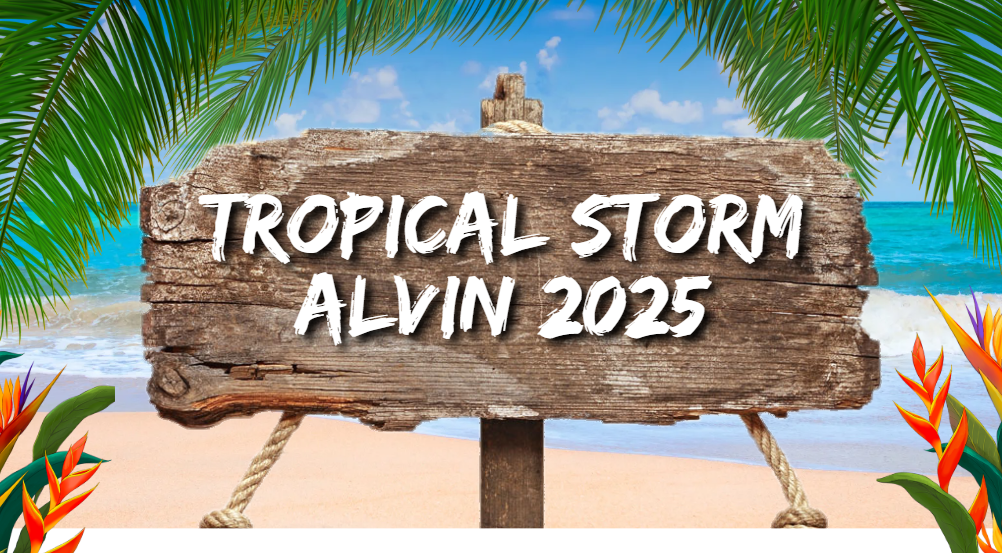Tropical Storm Alvin 2025 became one of the first named storms of the season in the Pacific Ocean. While it did not cause major damage, it still caught the attention of weather experts and people living near the coast.
ALSO READ : Cucumber Recall
This article will explain what happened with Tropical Storm Alvin 2025, how tropical storms form, and how you can stay safe during storm season.
What Is Tropical Storm Alvin?
It was the first named storm of the Pacific hurricane season.
Alvin started as a tropical depression, which is a low-pressure system with winds below 39 mph. As it gained strength, it was upgraded to a tropical storm, with wind speeds between 39 and 73 mph.
Even though Alvin stayed over the ocean and did not hit land, it showed how important it is to stay alert during storm season.
How Do Tropical Storms Like Alvin Form?
Here is a simple breakdown of how they form:
- Warm water rises and creates low pressure.
- Clouds and storms begin to form as the air cools.
- Winds start spinning because of Earth’s rotation.
- If the system gets strong enough, it becomes a tropical depression.
- When winds reach 39 mph or more, it becomes a tropical storm.
If it grows even stronger (winds 74 mph or more), it becomes a hurricane.
When and where did Alvin form?
Tropical Storm Alvin formed in May 2025, early in the Pacific hurricane season. The storm developed far out in the ocean, southwest of Mexico.
It moved westward, away from land, and stayed over open water. This helped prevent damage to homes and people.
What Was the Strength of Alvin?
Alvin did not become a hurricane. Its highest wind speed was about 50 mph, which makes it a moderate tropical storm. It also brought heavy rain and rough sea waves to the area.
Since it stayed far from land, Alvin was mostly watched by weather experts and ships in the ocean.
Why Are Tropical Storms Named?
Tropical storms are given names so that people can easily remember and follow them. The World Meteorological Organization (WMO) makes a list of names each year for storms in different regions.
The name Alvin has been used before in other years. It was used again in 2025 for the first storm in the Pacific Ocean.
Was Tropical Storm Alvin Dangerous?
Even though Alvin didn’t hit land, tropical storms can still be dangerous. Here’s why:
- Strong winds can damage boats and ships.
- Heavy rain can cause flooding if near land.
- High waves can be risky for coastal areas.
Luckily, Alvin stayed far enough from land, so it didn’t cause major problems.
How Can You Stay Safe During Storm Season?
If you live in a place that gets tropical storms or hurricanes, here are some easy tips to stay safe:
- Watch the weather forecast during storm season.
- Have an emergency kit ready with food, water, and medicine.
- Know where to go if you need to leave your home.
- Keep your phone charged and stay in touch with family.
- Follow advice from local officials and weather alerts.
Being prepared can save lives.
FAQs
Did Tropical Storm Alvin hit land in 2025?
No. Alvin stayed over the ocean and did not hit land.
How strong was Tropical Storm Alvin?
The highest wind speed was about 50 mph. It was a moderate tropical storm.
When did Alvin form?
Alvin formed in May 2025, early in the Pacific hurricane season.
Why is it called “Alvin”?
Storms are named using a list created by the World Meteorological Organization.
Can tropical storms become hurricanes?
Yes. If wind speeds reach 74 mph or more, the storm becomes a hurricane.
Should I worry about storms that don’t hit land?
Even if they stay in the ocean, storms can affect sea travel and bring rough waves to coasts. It’s always good to stay alert.
Conclusion
Tropical Storm Alvin 2025 was a reminder that storm season can start early and move quickly. While Alvin did not cause damage, it helped people and weather experts practice tracking and preparing for future storms.
If you live in a storm-prone area, always keep an eye on the forecast and be ready to act. Preparedness is key to staying safe.v

